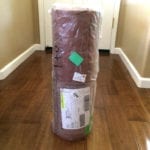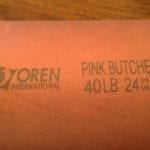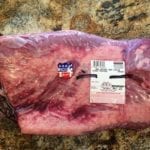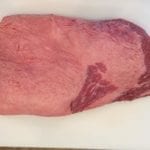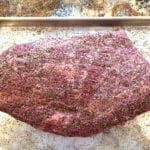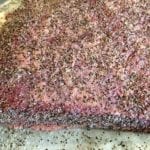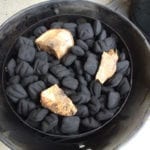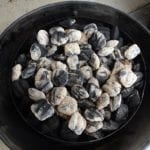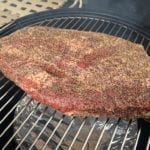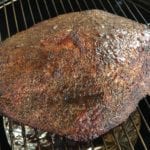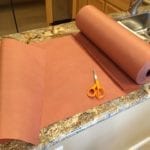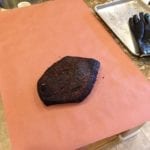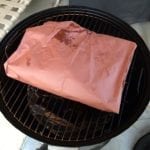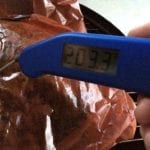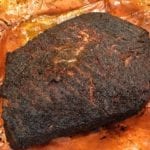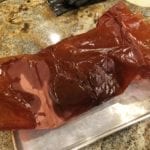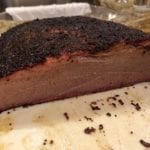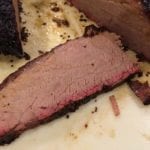Summary
- Buy a 6-8 pound USDA Choice brisket flat.
- Do not trim the fat side. Remove any fat and silverskin from the lean side.
- Apply a 50/50 kosher salt and coarse ground pepper rub just before cooking.
- Cook the brisket fat-side down at 250-275°F to an internal temperature of 165°F.
- Wrap in butcher paper and continue cooking until 200-205°F and probe tender.
- Rest in paper for 30 minutes before slicing.
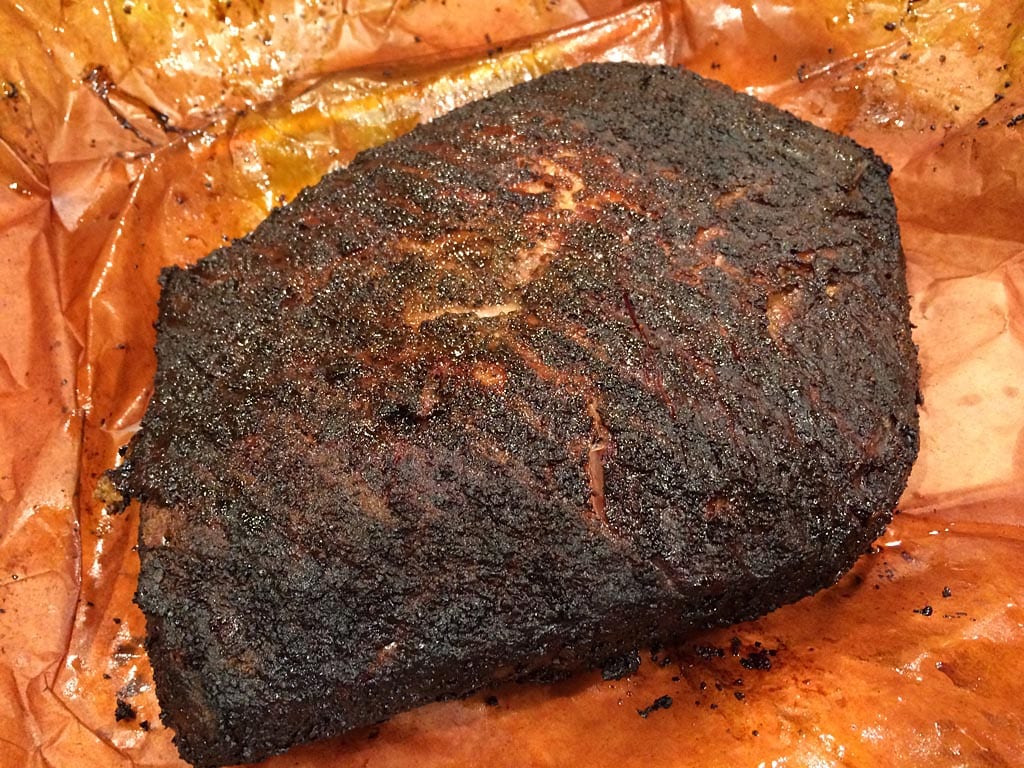
When I cook brisket, I prefer to cook a whole packer brisket. I like getting some lean meat and some fatty meat in a single cook, sort of a two-for-one deal. I also think the fatty point section helps protect the lean flat section from drying out. But on occasion I walk into the warehouse store and see a nice, big brisket flat in the meat case and it whispers, “Take me home and barbecue me,” and I can’t resist.
So here’s an 8-pound brisket flat I cooked using butcher paper. Pink butcher paper, to be precise. The brisket is wrapped in butcher paper part way through the cooking process to keep the meat from getting too much smoke, to help retain moisture, and to slightly accelerate the cooking process. The paper “breathes” more than aluminum foil, also known as the “Texas Crutch”, and some people think that’s an advantage over foil.
Why pink butcher paper? Because that’s what Aaron Franklin of Franklin Barbecue in Austin, Texas uses on the whole briskets he cooks at his famous restaurant. Franklin has single-handedly done more to boost sales of pink butcher paper than anyone in the history of…well, butcher paper. If you don’t know who Aaron Franklin is, you must be living in a cave without Internet service. Stop and read this article and this article right now.
OK, welcome back.
One downside to butcher paper is you cannot add beef broth or other liquids to it toward the end of the cooking process like you can when using aluminum foil. That’s OK for Central Texas style brisket because they’re not big on adding liquids to brisket. Franklin just lightly sprays the surface of the paper with apple cider vinegar, wraps the meat, and puts it back in the smoker to finish cooking.
Despite what you might think, butcher paper does not catch fire in the Weber Bullet as long as you run the cooker at normal barbecuing temperatures up to about 300°F. I haven’t tried cooking above that temp, so if you do you’re on your own. To be safe, keep a fire extinguisher nearby at all times.
What kind of butcher paper to buy? Look for 40 lb. paper (that’s a measure of thickness) that is at least 18″ wide, but 24″ wide is better. It costs a bit more, but it’s easier to wrap briskets using wider paper. You want an uncoated paper—no wax or plastic on one side. As for color, it’s not important, but if you want to make authentic Aaron Franklin brisket, you can order pink butcher paper from a number of suppliers.
What about using brown kraft paper or grocery bags instead of butcher paper? I wouldn’t. Who knows how it’s made or where it’s been? Paper suppliers say that butcher paper is made from USDA/FDA approved kraft paper, so there is a “food safe” aspect to butcher paper that is not guaranteed when using other papers.
Here’s a description and photos of how I cooked this brisket flat on July 14, 2014.
Source For Pink Butcher Paper
I ordered this roll of 24″ wide pink butcher paper from ABCO Paper in Austin, Texas. It’s hard to find on their website; it’s best to call them at 800-556-2677 to check on availability and pricing. The nice lady on the phone knew exactly what I wanted and was happy to take an order for a single roll.
It’s a lot of paper…1,000 feet, to be exact, and it doesn’t come cheap. This roll cost me $69 delivered, but it will last me forever. I learned later that you can buy smaller quantities of 24″ pink butcher paper at Amazon.com.
Select The Brisket
Choose the biggest, baddest USDA Choice brisket flat you can find, not a little wimpy one. You want a nice layer of fat on it to keep the meat from drying out.
The brisket above is a USDA Choice brisket flat weighing 8.06 pounds that I stumbled upon at a membership warehouse store.
Trimming the fat side of the brisket is up to you. Many will not trim a brisket flat at all, while others will trim the thickest areas of fat to about 1/4″ thick. I didn’t do any trimming on the fat side. I did remove some areas of fat and silverskin from the lean side of the brisket.
Learn more later: Brisket Selection & Preparation
Rub The Brisket
Apply a salt & pepper rub to both sides of the brisket and let it sit at room temperature while you fire-up the Weber Bullet. The rub recipe could not be simpler.
Central Texas-Style Salt & Pepper Rub
- 1/4 cup kosher salt
- 1/4 cup coarse ground black pepper
It’s important to use a coarse ground black pepper, not one that is finely ground. The Great American Spice Company sells a 16 mesh coarse ground black pepper similar to what Aaron Franklin uses.
Fire The WSM
Fire-up the Weber Bullet using the Minion Method—fill the charcoal chamber about 2/3 full with unlit Kingsford Charcoal Briquets. Tuck a few chunks of your favorite smoke wood into the unlit charcoal. I used 3 chunks of pecan wood. Spread 20-30 hot coals over the unlit ones. I used an upside-down Weber chimney starter to light the briquettes.
Line the water pan with aluminum foil suspended about 1″ above the bottom of pan. The air gap will help prevent the brisket drippings from burning during the cook. Do not add water to the pan.
Learn more later: Firing Up Your Weber Bullet
Barbecue The Brisket
Assemble the cooker with the empty, foiled water pan in place.
Put the brisket on the top cooking grate fat-side down and cover with the lid. The fat helps shield the lean brisket flat from the heat.
Set the top vent to 100% open and leave it that way throughout the entire cooking process. Start with all 3 bottom vents 100% open. As the cooker approaches 250°F, begin to partially close all 3 bottom vents to maintain 250-275°F. Adjust the bottom vents as needed to maintain this temperature range throughout the cooking process.
Barbecue the brisket for several hours until it reaches 165°F internal temperature. Check the temp by inserting an instant-read thermometer into the flat horizontally from the side.
As the brisket cooks, spray it a few times with a 50/50 mix of water and Worcestershire sauce, or with apple juice or your favorite concoction. Just wait a couple of hours to let the crust setup before spraying so you don’t wash away the rub.
When the meat reaches 165°F, spray generously one last time and wrap the brisket like a package in a large sheet of butcher paper and return it to the cooker.
Cook for another couple of hours until the brisket reaches 200-205°F internal temperature. Check for tenderness by inserting an instant-read thermometer through the paper vertically into the center of the flat. If it goes in and out like butter, the brisket is done.
Here’s how the temperature and vent settings went during my cook:
| Time | Lid Temp | Meat Temp | Vent 1 % | Vent 2 % | Vent 3 % |
| 11:30 am | – | – | 100 | 100 | 100 |
| 11:45 am | 250 | – | 33 | 33 | 33 |
| 12:00 pm | 240 | – | 33 | 33 | 33 |
| 12:30 pm | 238 | – | 33 | 33 | 33 |
| 1:00 pm | 264 | – | 33 | 0 | 0 |
| 1:30 pm | 274 | – | 25 | 0 | 0 |
| 2:00 pm | 267 | – | 0 | 0 | 0 |
| 2:30 pm | 268 | – | 0 | 0 | 0 |
| 3:00 pm | 260 | – | 0 | 0 | 0 |
| 3:30 pm (s) | 254 | 158 | 0 | 0 | 0 |
| 4:30 pm (s) | 252 | 161 | 0 | 0 | 0 |
| 5:15 pm (s) | 235 | 159 | 100 | 0 | 0 |
| 5:30 pm (s) | 260 | – | 100 | 0 | 0 |
| 6:00 pm (s)(w) | 290 | 165 | 25 | 0 | 0 |
| 6:20 pm | 290 | – | 0 | 0 | 0 |
| 6:30 pm | 270 | – | 0 | 0 | 0 |
| 6:45 pm | 260 | – | 0 | 0 | 0 |
| 7:15 pm | 255 | – | 0 | 0 | 0 |
| 7:30 pm | 242 | 190 | 25 | 0 | 0 |
| 8:00 pm | 275 | 195 | 25 | 0 | 0 |
| 8:30 pm | 240 | 205 | 25 | 0 | 0 |
(s) sprayed with 50/50 water and Worcestershire sauce
(w) wrapped in butcher paper
Note that the vent percentages represent the way I set the vents at the time indicated.
Rest The Brisket Then Slice
The photos above show the finished brisket coming out of the smoker. Keep the brisket wrapped in the paper and let rest at room temp for 30 minutes before slicing and serving.
To hold the brisket at temperature for several hours before serving, skip the rest, wrap with aluminum foil and towels, and place in an empty cooler. This should keep the meat at a food-safe temperature of 140°F or higher for 2-3 hours.
In Texas, it’s all about the meat and not about the sauce. Serve sauce on the side, if you like. Here’s a link to a recipe for Aaron Franklin’s Sweet Sauce at The Virtual Weber Bulletin Board that goes great with this brisket flat.
More Brisket Links On TVWB
- Brisket – High Heat
- Brisket – Smoked & Oven Finished
- Brisket – Midnight Cook
- Brisket – Wet Rub
- Whole Brisket – Central Texas Style Butcher Paper
- Whole Brisket – Competition Trim
- Burnt Ends – Kansas City Style
- Burnt Ends – Smoky, Sticky, Sweet
- Pastrami – Dry Cured
- Quick Pastrami – Smoked Corned Beef Brisket
- Brisket Servings Calculator
- Brisket Selection & Preparation
- Separating Brisket Flat & Point
- Using An Electric Oven To Hold Brisket At Temperature
- Camp Brisket 2020 Trip Report

